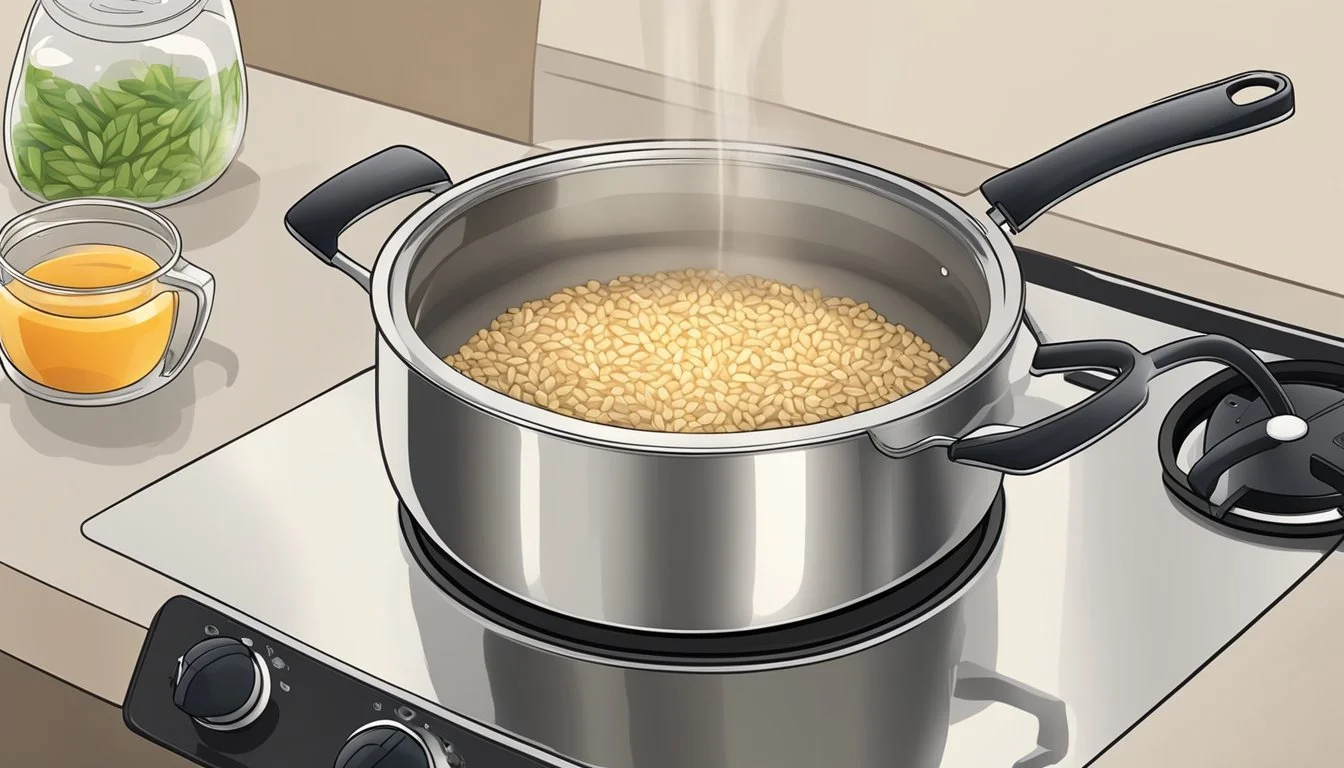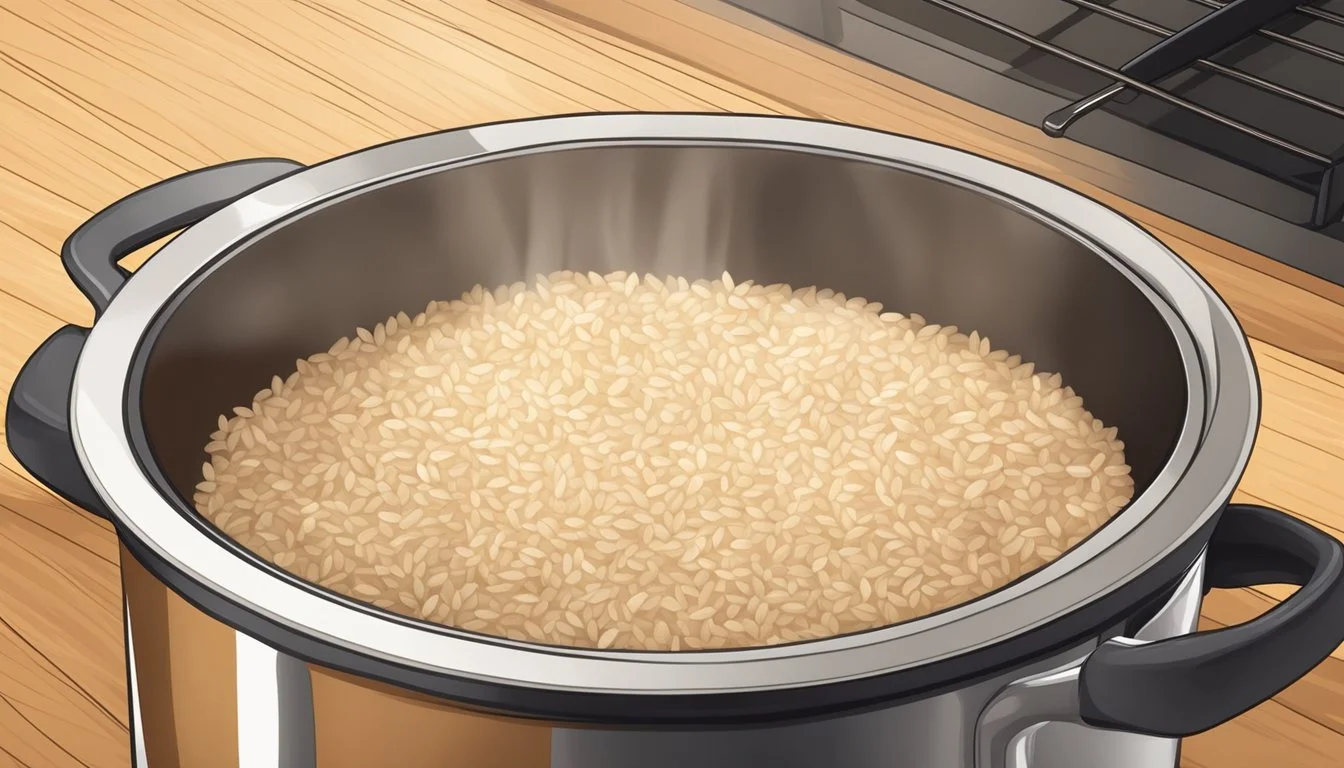How to Cook Brown Rice
Perfectly Fluffy and Nutritious Results
Brown rice is a nutritious whole grain that offers numerous health benefits. Rich in fiber and essential nutrients, it provides a hearty and satisfying base for many meals. Cooking brown rice is simple and requires only water, rice, and a pot with a tight-fitting lid.
The key to perfectly cooked brown rice lies in using the right water-to-rice ratio and cooking time. For every cup of brown rice, use 2 to 2.5 cups of water. Bring the water to a boil, add the rice, reduce heat to low, and simmer covered for about 45 minutes. After cooking, let the rice rest for 10 minutes before fluffing with a fork.
Brown rice's nutty flavor and chewy texture make it a versatile ingredient in various dishes. It pairs well with stir-fries, curries, and roasted vegetables. Incorporating this whole grain into your diet can contribute to improved digestion, better blood sugar control, and increased feelings of fullness.
Nutritional Profile
Brown rice packs a powerful nutritional punch, offering a range of essential nutrients. Its complex carbohydrate structure and fiber content contribute to its reputation as a healthy whole grain option.
Macro and Micro Nutrient Breakdown
A cup of cooked brown rice (195g) contains approximately 216 calories. It provides 44g of carbohydrates, 5g of protein, and 2g of fat. Brown rice is an excellent source of fiber, offering 3.5g per serving.
This whole grain is rich in B vitamins, particularly niacin and vitamin B6. It also contains essential minerals like manganese, selenium, and magnesium.
Brown rice is a good source of iron and potassium. One cup provides about 1mg of iron and 154mg of potassium.
The bran layer of brown rice contains phytochemicals and antioxidants, which may offer additional health benefits.
Comparing Brown Rice to White Rice
Brown rice retains its bran and germ layers, giving it a nutritional edge over white rice. It contains more fiber, vitamins, and minerals.
White rice has 242 calories per cup, slightly more than brown rice. However, brown rice offers nearly four times more fiber than white rice.
Brown rice has a lower glycemic index compared to white rice, potentially leading to better blood sugar control.
The bran layer in brown rice provides essential fatty acids, which are removed in white rice processing.
While both types offer similar protein content, brown rice contains more vitamins and minerals, making it a more nutrient-dense option.
Types of Brown Rice
Brown rice comes in various grain sizes and specialty varieties, each with distinct characteristics and culinary uses. The different types offer a range of textures, flavors, and cooking properties to suit diverse preferences and recipes.
Distinguishing Between Grain Sizes
Long-grain brown rice has slender kernels that remain separate and fluffy when cooked. It's ideal for pilafs and side dishes.
Medium-grain brown rice is shorter and plumper. It becomes slightly sticky when cooked, making it suitable for dishes like risotto or rice pudding.
Short-grain brown rice has round, stubby grains. When cooked, it becomes sticky and clumps together easily. It's perfect for sushi and rice balls.
Quick-cooking and instant brown rice varieties are pre-cooked and dehydrated for faster preparation times. These offer convenience but may have a slightly different texture than regular brown rice.
Special Varieties
Brown basmati rice has a nutty flavor and aromatic quality. It's a long-grain variety commonly used in Indian and Middle Eastern cuisine.
Black rice and red rice are specialty types with unique colors and flavors. They often have a chewy texture and nutty taste.
Wild rice, despite its name, is not true rice but a grass seed. It has a distinct earthy flavor and chewy texture, often mixed with other rice varieties.
Converted brown rice undergoes a special steaming process before husking. This results in a product that cooks faster and has a milder flavor than regular brown rice.
Preparing Brown Rice
Proper preparation is key to achieving perfectly cooked brown rice. Two crucial steps are rinsing the grains and using the correct water-to-rice ratio.
Rinsing and Soaking
Rinse brown rice thoroughly before cooking to remove excess starch and any debris. Use a fine mesh strainer and run cold water over the rice, gently agitating it with your hands. Continue rinsing until the water runs clear.
For improved texture and faster cooking, consider soaking the rinsed rice. Place it in a bowl and cover with water for 30 minutes to 2 hours. This step is optional but can help reduce cooking time and enhance digestibility.
After soaking, drain the rice in the mesh strainer again before cooking.
Water to Rice Ratio
The correct water-to-rice ratio is crucial for perfectly cooked brown rice. Generally, use 2 to 2.5 cups of water for every 1 cup of brown rice.
For firmer rice, use less water. For softer rice, increase the amount slightly. Adjust based on personal preference and the specific type of brown rice being cooked.
Add the measured water and rinsed rice to a pot. For enhanced flavor, replace some or all of the water with broth. A pinch of salt can also be added at this stage.
Cooking Methods and Techniques
Brown rice can be prepared using various methods, each with its own advantages. The key is to achieve the perfect balance of tender grains with a slight chewiness.
Stovetop Simmering
Stovetop simmering is a classic method for cooking brown rice. Start by rinsing 1 cup of rice under cold water. In a medium saucepan, combine the rice with 2 cups of water or broth. Add a pinch of salt if desired.
Bring the mixture to a boil over medium-high heat. Once boiling, reduce the heat to low and cover the pan with a tight-fitting lid. Simmer for 45-50 minutes without lifting the lid.
After the cooking time, remove the pan from heat and let it sit, covered, for 10 minutes. This allows the rice to absorb any remaining moisture. Fluff the rice with a fork before serving.
Using a Rice Cooker
Rice cookers offer a convenient, hands-off approach to cooking brown rice. Add 1 cup of rinsed brown rice and 2 cups of water to the cooker. Some models have specific settings for brown rice.
Close the lid and turn on the cooker. It will automatically switch to warm mode when the rice is done, usually after 45-60 minutes. Let the rice rest in the cooker for 10-15 minutes before opening.
Rice cookers maintain consistent heat and moisture, often resulting in evenly cooked grains. This method is ideal for those who prefer a set-it-and-forget-it approach.
Alternative Cooking Appliances
Instant Pots and other pressure cookers can significantly reduce cooking time for brown rice. Combine 1 cup of rice with 1¼ cups of water in the pot. Set to high pressure for 20-22 minutes, followed by a 10-minute natural release.
For oven-baked brown rice, preheat the oven to 375°F (190°C). Mix 1 cup of rice with 2⅓ cups of boiling water in an oven-safe dish. Cover tightly with foil and bake for 1 hour.
These methods can be particularly useful when stovetop space is limited or when preparing larger quantities of rice.
Perfecting the Texture
Achieving the ideal texture for brown rice involves balancing moisture and cooking time to create fluffy, tender grains with a pleasant chew.
Achieving Fluffy and Non-Mushy Rice
The key to fluffy brown rice lies in the proper ratio of water to rice. Use 2 cups of water for every 1 cup of brown rice. Rinse the rice before cooking to remove excess starch, which can lead to gumminess.
Bring the water to a boil, add the rice, and reduce heat to low. Cover and simmer for 45 minutes. Avoid lifting the lid during cooking, as this releases steam and affects the texture.
After cooking, let the rice rest for 10 minutes off heat. This allows any remaining moisture to be absorbed, resulting in perfectly tender grains. Fluff the rice gently with a fork to separate the grains.
If the rice is still too wet, drain any excess liquid and return it to low heat for a few minutes. For a nuttier flavor and slightly firmer texture, try toasting the rice in a dry pan before adding water.
Cooking and Recipe Ideas
Brown rice offers versatility and nutritional benefits in a wide range of dishes. Its nutty flavor and chewy texture complement various ingredients and cooking styles.
Integrating Brown Rice Into Your Meals
Brown rice serves as an excellent base for stir-fries, adding substance and fiber. Combine it with colorful vegetables like broccoli and Brussels sprouts for a nutrient-packed meal. For a quick side dish, sauté cooked brown rice with butter, olive oil, and herbs.
Create vibrant rice bowls by topping brown rice with baked tofu, roasted vegetables, and a flavorful dressing. Use leftover brown rice to make fried rice, incorporating eggs, peas, and diced carrots for a satisfying one-pan meal.
Brown rice also works well in sushi rolls, providing extra texture and nutritional value. Experiment with different fillings like avocado, cucumber, and smoked salmon.
Creative Recipes to Try
Elevate your brown rice game with unique recipes. Try a Mediterranean-inspired salad by mixing cooled brown rice with cherry tomatoes, feta cheese, and a lemon-olive oil dressing.
For a comforting dish, make a brown rice risotto using vegetable broth, mushrooms, and Parmesan cheese. The rice's natural nuttiness complements the earthy flavors of the mushrooms.
Create a hearty casserole by layering brown rice with seasoned ground meat, vegetables, and cheese, then baking until golden. For a vegetarian option, substitute the meat with lentils or beans.
Explore global cuisines with dishes like Indian-spiced brown rice pilaf or Mexican-inspired brown rice and black bean burritos. These recipes showcase the rice's ability to absorb and enhance various flavors.
Storing and Reusing Leftovers
Properly storing and reheating leftover brown rice ensures food safety and maintains quality. Following best practices prevents bacterial growth and preserves texture.
Best Practices for Preservation
Cool cooked brown rice quickly by spreading it in a thin layer on a baking sheet. Once cooled, transfer to airtight containers and refrigerate within 2 hours of cooking. Label containers with the date to track freshness.
Refrigerated rice stays safe for 3-4 days. For longer storage, freeze in portion-sized bags or containers for up to 3 months. Remove excess air to prevent freezer burn.
Keep rice at 40°F (4°C) or below in the refrigerator. Discard if left at room temperature for over 2 hours.
Reheating Without Loss of Quality
Microwave: Place rice in a microwave-safe dish. Add 1-2 tablespoons of water per cup of rice. Cover with a damp paper towel. Heat in 30-second intervals, stirring between, until steaming hot.
Stovetop: Add rice and a splash of water to a pot. Cover and heat over medium-low, stirring occasionally. Cook until internal temperature reaches 165°F (74°C).
Oven: Spread rice in a baking dish. Add water, cover with foil, and bake at 300°F (150°C) for 15-20 minutes.
Taste test and add seasoning if needed. Discard any rice with off odors or visible mold.




